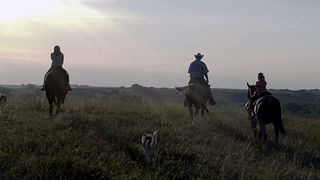BEEF SUSTAINABILITY: ENVIRONMENTAL, SOCIAL & ECONOMIC IMPACT
Not only is beef delicious and nutritious, but the beef industry continues to implement numerous proven sustainability practices throughout each and every step of the “pasture-to-plate” process that contribute to the way beef is responsibly raised today.
Though the path to sustainability is never complete. It is a continuous journey being carried out by farmers and ranchers responsible for raising and supplying beef to the U.S. and across the world. To the beef community, sustainability comprises much more than environmental considerations. Today, a sustainable food supply balances efficient production with environmental, social and economic impacts.
Let’s take a look at how today’s beef farmers and ranchers are contributing to a more sustainable food supply.
THREE PILLARS OF SUSTAINABILITY
A sustainable food system is comprised of three different, but intersecting, pillars: social responsibility, economic viability and environmental stewardship. True sustainability is a balance of these three aspects. Beef farmers and ranchers are dedicated to producing beef in a way that prioritizes the planet, people, animals, and progress.
Social
Perhaps the least explored of the three pillars is social sustainability. We define this as community and organizational resilience, based on principles such as equity, health, social capital, and well-being. For beef production, social sustainability includes worker safety, animal welfare, antibiotic and technology use, and the culture and traditions of beef producers.
economic
The economic pillar of sustainability refers to practices that support economic success and equitability, without negatively impacting the social and environmental aspects of the community. This includes improving rural economies & livelihoods, affordability of beef to consumers, profitability of beef producers, and the value of ecosystem services. Beef farms and ranches represent over 30% of the farms in the U.S., making up the single largest segment of U.S. agriculture, and a significant component of the agricultural economy.1
Environmental
This area is concerned with protecting and enhancing natural resources, ecosystem services, and ecological health. This pillar looks at biodiversity, carbon & water footprints, wildlife habitat, soil and rangeland health, and the ability of cattle to utilize human inedible feeds, among others.
"Continuing to build on the beef industry’s strong sustainability progress is critical to ensuring beef’s rightful place in a sustainable American diet. Beef plays a significant role in providing a healthy, nutritious diet, delivering high-quality protein, and contributing to positive health outcomes." - Shalene McNeill, Ph.D., RD, Executive Director of Human Nutrition Research at National Cattlemen’s Beef Association, a contractor to the Beef Checkoff Program.
SUSTAINABILITY ASSESSMENTS
Currently, emissions from cattle, including those that come from the feed production, fuel, and electricity only account for 3.7% of the total greenhouse gas emissions in the U.S. To better understand and optimize environmental sustainability across the entire beef lifecycle, from pasture-to-plate, cattlemen and women have recently invested in an updated environmental life cycle assessment (LCA). This in-depth assessment utilizes the most up-to-date and comprehensive methodology and includes data from seven different regions across the country. The LCA provides benchmarks on environmental contributions of the cattle industry in the U.S., and is a roadmap for the journey toward an even more environmentally sustainable approach to raising beef.
An economic impact assessment for the beef industry is also being completed. This economic impact report is one way to measure economic sustainability of the beef industry and is an area that will continue to develop and progress given the significant social and economic contributions of the beef industry to the U.S. and global community.
SUSTAINABILITY THROUGH THE BEEF LIFECYCLE
Cattle spend the majority of their lives on pasture, from the time they are born to when they are sent to the feedlot. During this time in the their diet consists primarily of grass, forages, and occasionally crop residues from grain production. By grazing, cattle expand the land available for food production by being able to consume forages on non-arable lands that are unsuitable for agriculture.
After the cow calf and backgrounding stages, cattle may spend the last 4-6 months of their life in a feedlot, where 50-85% of their diet is composed of grain from corn and other by-products, like distillers grains. By grain-finishing cattle, it shortens the time it takes to get from birth to harvest, thereby lessening their environmental impact, while increasing the total amount of beef produced per animal.
The beef production system works in harmony to produce the most sustainable product, balancing all of the trade offs that come with it. Each sector of the supply chain plays a critical role in doing so. When grazing, cattle are able to utilize their unique ruminant digestive system to upcycle, turning human inedible products, like grass, into high quality protein for human consumption. In doing so, the beef production system is not only a net contributor (meaning the beef production system produces more protein than it consumes) to the human edible protein supply, but the quality of human edible protein produced is enhanced throughout the beef value chain. However, a trade-off of this upcycling superpower is that cattle produce methane during the digestive process. This trade-off is balanced by feedlots, where cattle are fed grain. The higher-energy, grain-based diet consumed there produces less methane emissions than a high-forage diet. However, the net protein contribution is relatively less compared to when cattle consume a forage based diet. Overall, when considering livestock’s net protein contribution, beef and dairy cattle have the highest contribution, followed by poultry and swine. It is important to consider all trade-offs when evaluating sustainability, as each component of the supply chain plays a unique and important role in healthy, sustainable beef production.2
U.S. AS A WORLD LEADER IN EFFICIENCY & PRODUCTION
As a result of scientific advancements in beef cattle genetics, nutrition, production practices, and biotechnologies, the U.S. is a global leader in beef production efficiency. If the rest of the world were as efficient as the U.S., we could double global beef production, providing more high-quality protein for a growing population. In fact, the U.S. produces 18% of the world’s beef with only 6% of the world’s cattle.
While cattle finishing weights have been increasing over time, so have cattle’s ability to utilize energy more efficiently. In the United States, improvements in productivity allow beef cattle to reach harvest weight in a shorter amount of time than other countries. As compared to other countries, 2.66 cattle are required to produce the same amount of beef as one beef animal in the United States due to improvements in resilience and efficiency.3 In fact, the U.S. has the lowest emission intensity per pound of beef produced, and has been the world leader in this since 1996.4
The U.S. beef community has taken great strides in production efficiency but there seems to be some misconceptions about beef’s true role in greenhouse gas emissions – get the facts here.
Beyond the Beef
Beyond delicious and nutritious steaks, roasts and burgers, there are hundreds of uses for cattle by-products. Do you own a car, take a bus or ride a bike? If so, you’re utilizing by-products in the tires on your vehicle and the asphalt on the road. Even items that may seem trivial, such as dyes, inks, adhesives and plastics are made from cattle by-products.
Here are a few ways in which cattle by-products touch our lives:
- Hides from cattle are tanned into leather becoming shoes, purses and wallets.
- Cattle organs and glands are used in the production of medicine, insulation, antifreeze, shampoos/conditioners and instrument strings. Some cattle tissue can even be used in human heart valve surgeries!5
- Photo film, vitamin capsules, charcoal and glass are all derived from bones and horns of cattle.
- Inedible beef fat provides us with airplane lubricants, hydraulic brake fluid, biodiesel and medicines.
It is also critical to consider the ecosystem services provided by raising beef. This includes mitigating the risk of wildfires, in addition to benefits from grazing lands such as water regulation & purification, carbon sequestration, and wildlife habitat. The value of these services, estimated at $14.8 billion6 combined with beef’s significant economic contribution to the U.S. economy, are further contributions that must be considered when looking at sustainability across the livestock industry.
YOUR ROLE IN SUSTAINABILITY
Sustainability is never complete, and everyone has a role to play in helping create a more sustainable food supply. Approximately one-third of all food produced for human consumption in the world is lost or wasted, which places a substantial burden on global sustainability issues, including greenhouse gas emissions and food security. While 18% of food waste occurs at the restaurant and food service level, 43% of food waste occurs in the home.7
The food an average American family wastes translates into about $2,500 per year. According to the United States Department of Agriculture (USDA), beef is one of the least wasted foods, with 20% spoiled or not eaten, but that still leaves a lot of room for improvement! If beef waste were cut in half, the sustainability of the whole industry could be improved by 10%. Consider how you’ll use leftovers and make sure your appliances are running efficiently.
Throughout the beef cycle, each sector continues to make efforts to improve their sustainability. Many of the ways in which cattle contribute to a sustainable food system incorporate inherent trade-offs, which are important to recognize when considering the sustainability of beef production, and its environmental, economic, and social contributions to society.
Please visit beefresearch.org for additional in-depth beef sustainability information.
Subscribe to our newsletter so you don't miss the best recipes, cooking tips, and more.
Privacy Policy- https://www.beefresearch.org/CMDocs/BeefResearch/Sustainability_FactSheet_TopicBriefs/ToughQA/FS18SustainableFoodSystem.pdf
- Baber, JR et al. 2018. Estimation of human-edible protein conversion efficiency, net protein contribution, and enteric methane production from beef production in the United States. Translational Animal Science 2(4): 439-450.
- https://www.beefresearch.org/CMDocs/BeefResearch/Sustainability_FactSheet_TopicBriefs/ToughQA/FS19ProductivityAffectsSustainability.pdf
- Climate Watch Data. Agriculture. Found on https://www.climatewatchdata.org/sectors/agriculture?emissionType=136&emissionsCountry=EUU&filter=#drivers-of-emissions; FAO-STAT. Emissions intensities. Found on http://www.fao.org/faostat/en/#data/EI
- https://www.heart-valve-surgery.com/cow-valve-replacement.php
- Taylor, DT, et al. 2019. National and State Economic Values of Cattle Ranching and Farming Based Ecosystem Services in the U.S. University of Wyoming Extension B-1338.
- ReFED. 2016. A roadmap to reduce US food waste by 20 percent. Found here.







